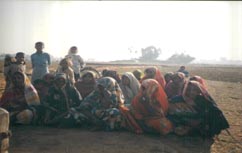Microcredit makes a little money go a long way
The international development community, in its quest to reduce global poverty, has focused its efforts on large infrastructure projects intended to encourage the growth of industry and spur job creation. One only need visit a developing country like India or Peru to see that the traditional model of development banking and grant aid is amiss. While some of the failures can be attributed to corruption and the slow pace of market reforms, it is important to reconsider the strategy of focusing exclusively on the industrial sector of the economy.
 Microcredit recipients at a CASHPOR (Credit and Savings for the Hardcore Poor) meeting in Uttar Pradesh
Microcredit recipients at a CASHPOR (Credit and Savings for the Hardcore Poor) meeting in Uttar Pradesh
Most of the poor in developing countries would be left behind, even in a burgeoning economy experiencing growth in manufacturing and technology. They are, as Lester Thurow of MIT identifies them, the "lumpen proletariat", uneducated and unequipped to participate in the formal economy. They are however, participants in an extremely large "informal" sector of the economy where they run small farms, teashops, vegetable stands and engage in every other type of human endeavor imaginable. While they may not be literate, they have the skills and judgment to survive in an unforgiving environment without the benefit of state sponsored welfare.
In countries where informal economies involve more participants than the formal sector, the poor receive the greatest benefit from development programs that enhance their income generating abilities. Microcredit lending, the practice of offering small loans to the poor, has shown great promise in reducing poverty around the world and is gaining acceptance by organizations like the World Bank and the UNDP.
While the practice of microcredit lending was developed independently around the world in the 1970s, the largest and most acclaimed microcredit institution is the Grameen Bank of Bangladesh. Founded by Mohammed Yunnus, an economics professor, the Grameen Bank demonstrated the following:
There are now microcredit institutions in almost every developing country. Cashpor (Credit and Savings for the Hardcore Poor) is a network of Asian Grameen Bank replicators with member institutions like ASA in China, India, Indonesia, Malaysia, Nepal, Philippines, and Vietnam. Member institutions have a combined outreach of over 200,000 borrowers and savers. Cashpor serves as a consulting/best practices group with the charter of promoting the growth and financial self-sufficiency of its members. A similar network, Accion International, represents the needs of microcredit institutions in Latin America. The "Microcredit Summit" is a global initiative, with the stated goal of reaching 100 million of the poorest families around the world by 2005. Its participants include microcredit practitioners, government donor agencies, and development banks (e.g. World Bank).
In order for microcredit services to reach a substantial portion of the worldõs poor, microcredit banks need to evolve into commercial financial institutions. Most currently operate as non-profit trusts and must rely on loans from donor bodies that stipulate a maximum lending rate. This severely limits possibilities for expansion and puts financial self-sufficiency out of reach. Some microcredit lenders, like BancoSol of Bolivia and SEWA of India have been successful in making the transition to commercial banks.
Microcredit banking offers a sustainable approach to poverty alleviation and empowerment for the poorest of the poor. Unlike infrastructure intensive development spending, it directly benefits the disadvantaged. In the long term, coupled with the investment in human resource development advocated by Amartya Sen, it is sure to create a global population well equipped to participate in every sector of the economy.
Kumar Thangamuthu, a member of the India Development Service, works for a leading technology company in the United States, and is currently pursuing his MBA degree at the University of Chicago. Feel free to respond to this article; you can write Kumar directly using the email link above. Also, be sure to check out the other part of this issue's twin artilces on microcredit, where Kumar profiles Activists for Social Alternatives, a microcredit institution operating successfully in India.
